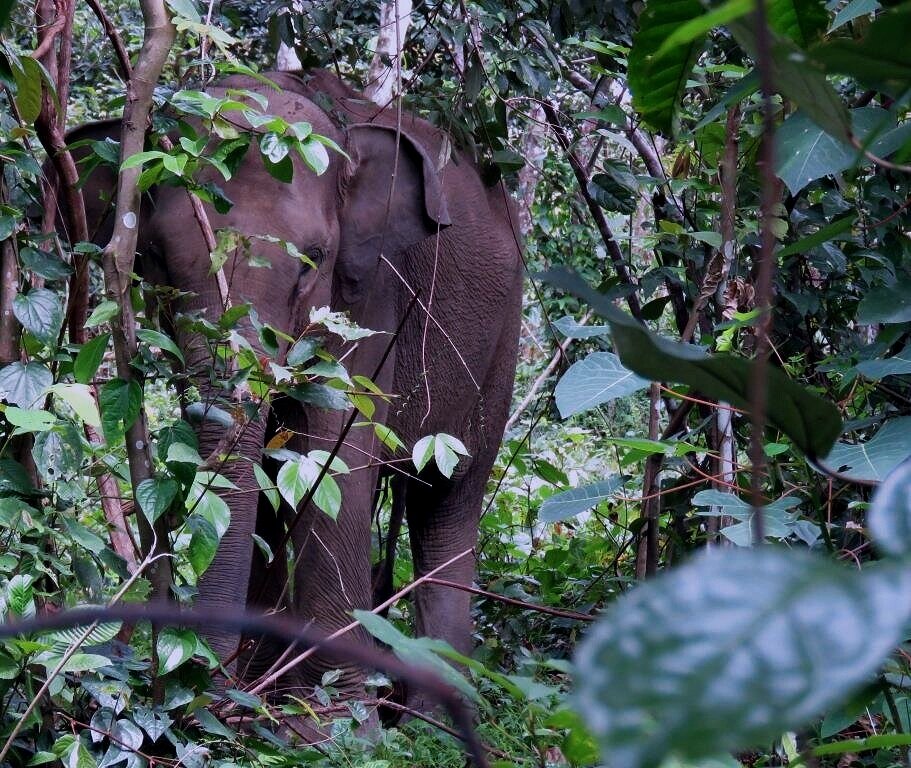
Elephants
Asian Elephants
The Asian elephant is separated into three subspecies; Elephas maximus indicus from mainland Asia (India, Thailand, Cambodia, Laos and Vietnam), E. m. maximus found in Sri Lanka, and E. m. sumatranus found only on the island of Sumatra. Formerly, all Asian elephants had remarkable ranges, and were widely distributed throughout these countries but, due to human pressures, all remaining Asian elephant ranges are now highly fragmented and their movement between areas is restricted. African elephants are present within 37 countries, and population estimates range between 470,000 to 690,000 individuals. However, in the case of the Asian elephant, the situation is becoming more and more critical.
Historically, Asian elephants ranged from west Asia, India, southeast Asia and China. Today, the Asian elephant now only remains in 13 countries, in highly restricted, human dominated habitats, and population estimates of all 3 subspecies together range between 25,000 to 45,000 individuals. The number of many remaining wild populations is unknown and therefore in reality, the true figure is probably at the lower end of this current estimate. Owing to the rate of habitat loss in their last remaining refuges and high levels of conflict with humans, this situation is set to get worse over the next few years, with several sub species predicted to go extinct without radical efforts being made to halt their decline.
The plight of the Sumatran Elephant
Up until the 1930’s, the Sumatran elephant inhabited the entire island of Sumatra, with a continuous distribution from the north to the south. The species largely populated lowland forest areas, but ranged from coastal areas up to an altitude of 2900m. By the 1980’s, only approximately 50% of natural forest remained on the island of Sumatra, and a rapid ‘island-wide’ assessment conducted in 1985 found elephants persisting in 44 distinct populations across eight provinces; from Aceh in the north to Lampung in the south, with a total population estimated between 2,800 and 4,800 individuals. However, by 2008, only 20 of the 44 areas identified in 1985 still contained elephant populations.
From 12 populations identified in Lampung province in the south of Sumatra in 1985, only three were still present in 2002, with one not considered viable due to too few individuals. In Riau province in central Sumatra, the elephant population had declined by 84% in less than 25 years due to Riau’s rapid deforestation rates.
In 2009, a survey of nine forest blocks previously containing elephants revealed six herds had been lost, and by 2010 elephant populations were completely extinct from west Sumatra. In the north of the country in the province of Aceh, elephants still exist in moderate numbers, though distribution is becoming more and more fragmented due to huge deforestation rates, and man-made barriers of large-scale oil palm and rubber plantations replacing the once forested habitats. In one elephant generation (approximately 25 years between 1985- 2008), over 69% of potential elephant habitat was lost, which also meant over 50% of the island’s elephants disappeared with it. In the centre and south of Sumatra, much of this ancient tropical forest now remains in blocks of less than 250km2, too small for viable elephant populations to survive. Although overall, Asian elephant populations have remained stable in the past 20 years, Sumatran elephants have drastically declined, with the population estimate now standing at ~1724 individuals. Despite this, up to date information on the distribution and population size of Sumatran elephants is lacking for many remaining populations, especially in the north of the country.
The Sumatran Elephants of Aceh and North Sumatra
The Gunung Leuser National Park is part of the Leuser landscape, measuring approximately 2.6Mha. Together with the Ulu Masen protected forest to the northwest, it forms the largest natural forest and biodiversity area, and is of global significance. This ecosystem is believed to support one of the largest remaining population of elephants in Sumatra, though actual population estimates are unknown due to lack of studies here. Studies conducted in south Sumatra has revealed a population of ~247 individuals in Way Kambas National Park (Wildlife Conservation Society 2010), and 104 individuals in the Bukit tigapuluh landscape (Frankfurt Zoological Society 2011). In 2016, Forum Konservasi Leuser (FKL), an in-country non-Governmental organisation, identified and mapped elephant distribution in Aceh province based on sightings from their patrols, and discovered there is no longer a contiguous tract of elephant habitat from north to south and instead, two separate areas containing elephants remain. This ‘separation’ may have huge impacts on the remaining elephant populations by limiting elephant movements and reducing genetic diversity leading to nonviable populations that are functionally extinct. This separation also fragments the habitat and brings elephants into close contact with humans, leading to increased conflict and killings of elephants, and injuries to people.
Necessity of elephants for tropical forest ecosystems: Gardeners of the forest
As much as the elephant’s survival is based on their tropical forest ecosystems, the ecosystem relies on elephants for its existence, exhibiting a mutualistic relationship. As the largest frugivores on earth defecating over vast ranges, they act as seed dispersers and are therefore essential drivers for ecosystem function. The disappearance of elephants will result in reduced or no dispersal for some plant species, causing a catastrophic result for whole rainforest plant communities. Large frugivores such as the Sumatran orangutan and rhinoceros may have once helped with the role of seed dispersal, though their population declines and range shrinkage means it is highly unlikely that could provide an ecological replacement to the Sumatran elephant. If elephants are lost from Sumatran forests, it is highly likely tropical rainforests will lose valuable tree species, having huge effects on other animals reliant on these for survival and therefore lead to the eventual disappearance of the forest itself.
The future of the Sumatran Elephant
For genetically functional populations of the Sumatran elephant to survive, these large bodied mammals require sufficient areas of suitable habitat to meet their dietary requirements; elephants eat up to 600 pounds of vegetation per day and drink 50 gallons of water! As critical habitats for the Sumatran elephant continue to be encroached by humans and dominated by agriculture, elephants are being forced into smaller and smaller isolated patches in less suitable areas (including more mountainous areas, where valuable food sources may not be present) or into agricultural areas, where they come into contact with humans. The additional effect of climate change also imposes the importance of suitable habitat areas being available. Most species have the ability to adjust to climatic affects in situ by altering their geographic ranges. However, this ‘coping’ mechanism is constrained if potential habitat has already been lost or human barriers limit the capacity of elephants to move to ‘refuge areas’. Home range and preferred habitat availability are critical for the Sumatran elephant’s long-term survival.

Sumatra’s Captive Elephants
Elephants all over the world have attracted the attention of humans for millions of years and have been depicted in mythology, religion, symbolism and cultural beliefs, especially throughout Asia. Historically, in many Asian countries wild elephants have been captured for ‘domestication’ and used in war, cultural festivals and as ‘beasts of burden’, being put to work in logging concessions. In Acehnese society, the domesticated elephant had several names; pomeurah, pobeuransah, teuku-rayek and tanoh mayong which were used in their daily speeches as a mark of respect towards these animals.
Indonesia used to traditionally manage captive elephants up until the 19th century and in 1984, the Indonesian government began a programme involving the capture of ‘problem’ wild elephants involved in human elephant conflict (HEC), translocating them to ‘Elephant Training Centres’ (ETC’s) for ‘taming’. According to the 1990 IUCN Asian Elephant Conservation Action Plan, the idea of these centres was to promote a greater respect for these elephants, increase awareness of the conservation need of wild populations and gain support from the local communities. In 2000, however, this program was discontinued due to the huge effect this was having on wild populations though by this time, approximately 700 elephants had already been removed from the wild.
These ETC’s, now renamed Elephant Conservation Centres (ECC’s), are found in 6 locations around Sumatra (Aceh, North Sumatra, Riau, Benkulu, South Sumatra and Lampung) within 10 ECC’s. However, these centres have experienced various problems over the years due to lack of knowledge on elephant husbandry and low income provided for adequate care. This had led to over crowded facilities, physical and psychological stress from under activity, boredom and lack of stimulation, thus many captive elephants suffered stress from inactivity from being chained in one spot for long periods. Due to overcrowding, many elephants were left for long periods with inadequate food and water, meaning their overall condition deteriorated. Even when training had been undertaken allowing mahouts to safely lead elephants to areas to find food, many of these places were too small to sustain large numbers and food resources became depleted quickly.
Poor water quality was also an issue, especially during the dry season if the centres were not located to fast following rivers. Many health problems were found including intestinal worms, bloat, and foot and wound infections from relatively low understanding and knowledge from care givers. Inadequate supplies of veterinary drugs and equipment meant that often elephants went without appropriate treatment.
A bulhook, used by mahouts to control elephants. This often causes serious painful injuries to the elephant.
To try and combat these problems, Conservation Response Units (CRU’s) were created across the country, to redistribute the elephants into smaller, more manageable groups, and to use these captive elephants to help alleviate HEC and aid in protecting the remaining wild populations. CRU elephants patrol the jungle for illegal activities and help to drive wild populations away from farms back into the forest. Except for a few elephants in tourist areas, safari parks and zoo’s, the majority of captive elephants either reside at ECC’s or CRU’s.
CRU’s are still present across Sumatra to this day, and many still use elephants to patrol and help alleviate conflict incidences around forest borders. However, many still lack sufficient funds to provide adequate care for their elephants, and many now also use local and international tourism including riding and washing to supplement their income. Lack of funds, low salaries for mahouts and veterinarians and no management policy in place mean many elephants in CRU’s still have various health problems and a low standard of welfare.





